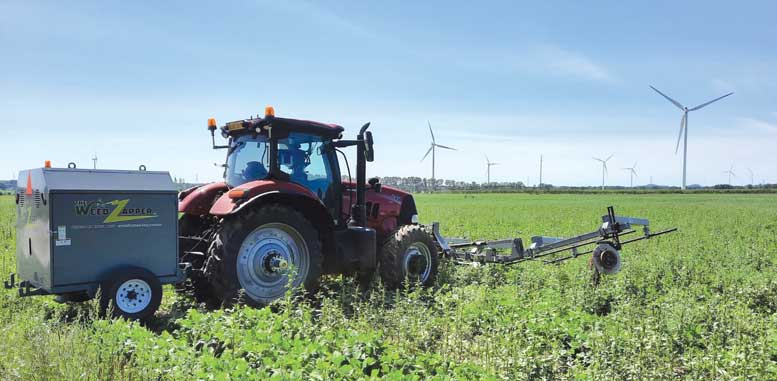|
Click to listen to this article
|
By Christopher G. Galbraith and Sushila Chaudhari, Michigan State University
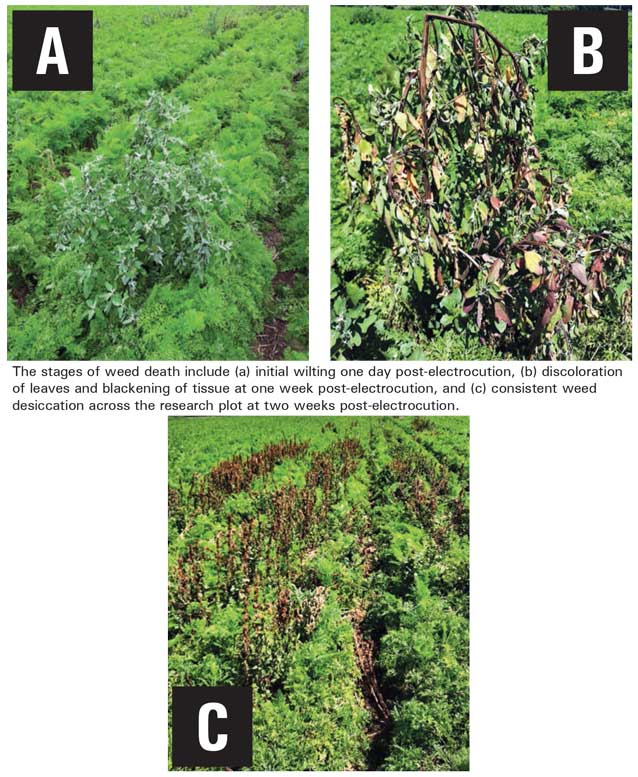
Carrot growers have faced their share of weed control challenges in recent years. Growing resistance to herbicides from important modes of action, such as the photosystem II inhibitors (Group 5), has led to reduced efficacy and an increasing number of escaped weeds. These escapes threaten yield potential in future seasons if allowed to reach reproductive maturity and disperse seed, increasing not only weed pressure but also prevalence of resistance genes in the population.
When early-season control fails, new practices are required to handle these larger weeds that are no longer susceptible to herbicide application. The standard strategy in west Michigan and other regions is to hire teams of hand labor to manually remove weeds before they are able to set seed, a practice which poses a major financial burden to growers. As the need for better late-season control continues to rise, growers are looking for new tools and technologies that will help them take action.
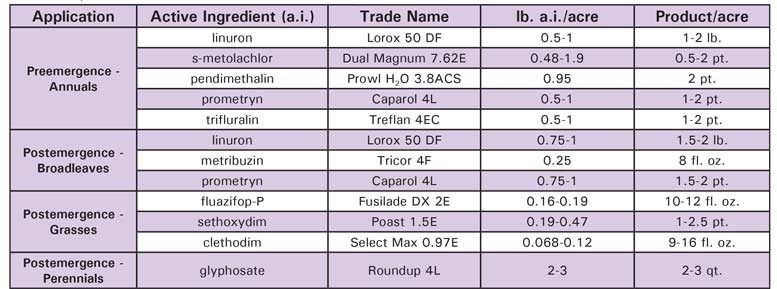
Herbicide Programs for Early-Season Control
Beginning the season with strong control through selection of effective herbicides and practices is essential for optimizing yield in slow-emerging crops like carrot. Surface cultivation, flame-weeding or application of a burndown herbicide can be used to clear existing weeds prior to crop emergence. Numerous cultivation implements can be used for between/in-row weeding throughout the season.
Preemergence chemical options include linuron (Lorox 50DF), pendimethalin (Prowl H2O), prometryn (Caparol 4L), S-metolachlor (Dual Magnum) and trifluralin (Treflan 4EC). Linuron and prometryn can also be used postemergence for broadleaf control, along with metribuzin (Tricor 4F). Postemergence options for grasses consist of fluazifop-P (Fusilade DX 2E), sethoxydim (Poast 1.5E) and clethodim (Select Max 0.97E). Herbicide application rates can be found in Fig. 1.
While starting out with effective control is crucial, it is also important to plan for control of escaped weeds later in the season as part of an overall integrated weed management program.
Electrical Weeding: A New Option for Late-Season Weed Control
Electrical weeding is an emerging technology that is sweeping across many agronomic and horticultural crop industries. Commercial equipment is available that terminates weeds through contact with a tractor-mounted, high-voltage electrode which is charged via a power take-off driven generator/transformer system. Upon contact, the current is conducted through the weed as it returns back to its source through the soil and a grounding device. Electrical energy is converted into heat as it moves through the plant, causing systemic tissue death. This novel practice is being leveraged as a form of late-season weed control by Michigan carrot growers to manage escapes, resistance and the weed seed bank.
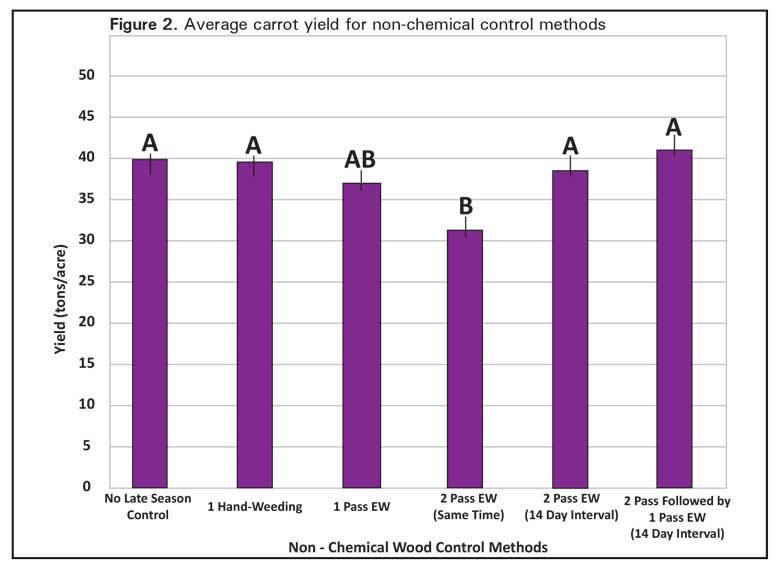
A summer 2021 research trial at Michigan State University put electrical weeding to the test by evaluating its success within various control programs. Different combinations of early-season Prowl/Lorox applications with variable timing and number of electrical weeder passes performed later in the summer were compared in terms of crop injury and weed control. Yield data and in-season foliar injury ratings were collected to discern the level of inadvertent crop damage. Carrot root subsamples were also taken at harvest to determine both average length and extent of damage to internal tissue from the electric current.
Results show that two electrical weeder passes applied at the same time is optimal in terms of balancing control and operating costs. No evidence was found to indicate that any of the electrical weeding treatments cause damage to the crop’s internal root structure. Two electrical weeder passes in succession did show slightly higher foliar injury. However, there was no meaningful difference in carrot yield or length between any of the non-chemical treatments (Fig. 2, Fig. 3) besides slight variation resulting from higher weed pressure found in plots where two passes were applied in succession.
This finding indicates that electrical weeding’s primary benefit may not be so much that it boosts yield in the current season, but that it can reduce pressure in later years by eliminating mature weeds before they set seed. Electrical weeding serves as a form of long-term weed management when employed to clean up fields following early-season control practices, preventing further replenishment of the weed seed bank and escaped weeds from interfering with harvest.
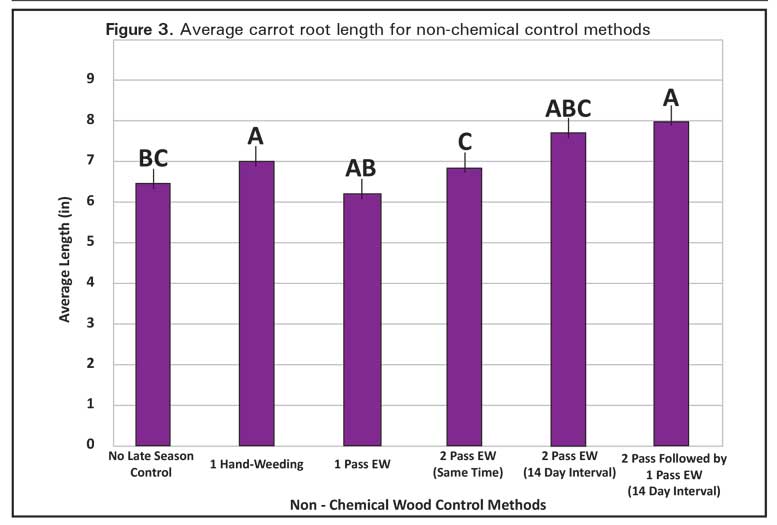
These preliminary results showing electrical weeding’s effects on weed control and crop damage are just the beginning in terms of the potential of this new technology. The current research program at Michigan State is testing the effects of electrical weed control on environmental factors such as weed seed viability and microbial populations inhabiting the root zone. Data from the research is also being used in constructing a profitability analysis between electrical and hand-weeding to determine which is more cost effective. There is also growing interest around the potential of electrical weeding for elimination of bolting carrots in order to prevent harvest of these unmarketable roots. As growers are faced with the dire challenge of controlling resistant weed populations, electrical weeding shows promise as a viable option for improving integrated weed management in modern carrot production.
Authors’ note: Funding for this research was provided by USDA National Institute of Food and Agriculture (NIFA) Hatch Project number MICL102562, MDARD State Specialty Crop Block grants, USDA NCR-SARE Graduate Student Grant and the Michigan Carrot Research Committee.

